|
~All images below
are clickable - click them to see a larger higher quality
image~
Wind Power…The Jacobs Wind Electric Company
In late fall of 2010, I happened on an ad on Craigslist,
for a Windmill on a 50 foot tower. There were no pictures,
so I called the fellow that had it for sale, went out &
saw it, and fell in love with it at first site. It was an
old Jacobs Electric Company Windmill, rated at 110VDC &
3KW, in good condition, with tower, and the fellow that
owned it had been using it to run electric space heaters
for heat in winter, when the wind blew. He was really helpful,
but he wouldn’t climb the tower to take it down for
me…no matter WHAT I said!
We made a deal on it, and I told the Seller (who was &
is an awesome guy!) that I would be out in spring to take
it down & remove it. I didn’t want any part of
taking this down in colder weather….here’s what
the mill looked like when I first saw it:
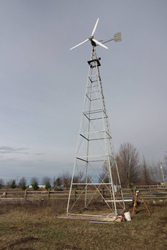
In springtime, as soon as it was even semi-warm, I started
planning the move.
Knowing that I had to take the head down (DREADING this…),
I did as I normally do, I dove in headfirst.
Went out to the place, started taking out the bolts that
hold the tower in and had a crane come out to lift the head
(generator) off of the top of the tower. A couple of observations…
(A) When there is very little wind at the base of the tower,
it IS windy at the top.
(B) The first time I climbed the tower was terrifying,
held on like a cat with 6 legs every step, every movement.
(C) The head is a LOT bigger up there than it looks on
the ground.
I got everything unhooked at the top and the crane arrived.
We hooked the crane’s cable to the generator head,
lifted it as slowly & gracefully as we could, (which
was not graceful) & lowered it to the ground, softly.
Then, I climbed partway down the tower and attached the
crane’s strap to the tower, maybe 2/3 of the way to
the top, and we unbolted the rest of the bolts, allowing
the crane to lift it & then lower it to the ground,
in one piece.
A long sigh…..of relief.
A few days later, a warm Sunday morning, I took my truck
& trailer over and after unbolting the tower at it’s
midsection, (cutting it in two assembleable pieces), the
Seller helped me load it with his tractor, onto my trailer.
It wasn’t all that heavy, BUT it WAS tall, even laid
down. I was afraid of bridges with it on my trailer, so
I drove it home & went around all three overpasses on
I-90 on the way home. Here’s what it looked like on
my trailer when (RELIEF!) it finally arrived home!

I had been speaking with a few different people on the
mill, I wanted as much information on it as a could get,
and I decided to take a long ride in an airplane to meet
up with one of the friendliest guys I met on the Jacobs,
and one with a LOT of experience with them, in Oklahoma
City, OK. I flew down there, and spent a day with Pete Kubeck,
who is just nothing short of AWESOME, and watched his (3!!!!!)
mills making power all day long! Pete showed me & taught
me more than books ever could about these machines, how
well they are made, why they last so long, and what to fix,
look out for, and how to set a tower, etc. I just can’t
say enough about Pete, he has become a fast friend to me,
and is in my opinion what America is all about. Here are
a couple of pictures of Pete, and his mills:
After my trip to OK City to see Pete, I came home, and
the REAL work began…..
I had decided to get a Permit for this, as I have (1) Neighbor
that I am SURE would report me to the FAA, CIA, DEA &
every Agency you can think of IF I didn’t get a permit,
so I went to the County to get one, thinking “this
won’t be that big of a deal, I’ll just get it
done!”
Wishful thinking.
The guy I bought the mill from had installed it, on a Permit,
in 2001. He had engineering plans made up FROM an engineering
company when he installed it. I took them with me to the
County, submitted them and then here comes trouble…..
According to the County, my ENGINEERED plans wouldn’t
work, because they weren’t up to 2009 IBC Standards.
(“IBC” is INTERNATIONAL Building Code). Yes, Americans,
we are now forced, EVEN here in North Idaho, to adhere to
“International Building Codes”. So, I had to take
the plans to an engineering firm, and pay an additional
$1500.00 to have the RESEARCH the “IBC” codes
to ensure that my engineering plans (for the windmill that
stood for the previous 74 YEARS) were good enough….
After MUCHO irritation, I got my “Approval!”
& started digging.
I had decided to put the mill at the end of my driveway,
the best spot for catching what are prevailing winds here,
from the south-southwest. My home faces NW, with Coeur d’Alene
Mountain behind us, so the mountain protects my house (pretty
much) from super winds, but the mill demanded as high &
much winds as I could get, so the end of the driveway, in
my yard, was the ticket.
The plans for concrete were fairly insane:
(A) A foundation poured 18 inches thick with rebar across
the entire issue
(B) (4) concrete manholes a total of 6 feet high, filled
with concrete around the legs
Here’s a picture of the ground prior to my excavating
it out:
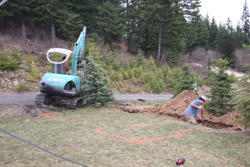
So, now after excavation, I had a friend who is an excellent
Mason come over & help me pour the foundation. We poured
it on a cold, blustery rainy sleety day in the beginning
of April, and the Inspector that came out was actually quite
a good guy.
While all of this was going on, a lot of other things were
happening.
One was that a great friend & neighbor decided to document
all that I was doing. This is a pretty awesome thing, because
had he not done this, I wouldn’t have nearly anything
on what all I accomplished, in terms of pictures! The other
thing that was happening was the rebuild of the Generator
itself, along with the governor.
This pic is the blades, laying on the ground, just showing
a little of the size involved. They are actually about 7
feet or so long, each, so with the governor, I think they’re
a little over 15 feet or so. (YES that is a DETROIT LIONS
shirt I’m wearing, GO LIONS, PLAYOFFS!!!!!!)
These two pictures are the tower, laying down in two pieces,
in my front yard.
I want to tell anyone who ever does this about reassembling
a tower….there is NOTHING easy about this. There are
(4) bolts that attach each leg to the one below it, and
another (2) bolts that attach the crossing steel straps
at each corner. Probably the first 7 or 8 lined up easy,
the rest were WAR. The tower is meant to be assembled piece
by piece, climbing it, as in the manual from Jacobs. When
you lay it down, you twist the tower (not bend) and it is
a PAIN to get everything lined up….took me sometimes
hours to get one bolt hole to line up. I wouldn’t wish
it on anybody…
At this point, I went to Western Concrete Products in Spokane,
WA, and ordered a bunch of Concrete Manholes & Drywells.
(The drywells for use in my spring that we developed, a
different article). This picture shows the trailer, full
of concrete parts, being delivered to my house, and us lifting
them off with the help of another friend’s backhoe.

A word of advice; the entire truck I had delivered cost
about $1200.00, INCLUDING delivery. That’s because
everything I bought was “seconds” or defective
products. I didn’t care, though, because nothing I
bought needed to be structurally sound. None of it would
need to hold water, or be watertight, so I saved a LOT of
money, probably a minimum of 6-8 THOUSAND dollars. You can
buy “seconds” for the price of the concrete itself,
and they generally have a lot of “seconds” laying
around, FYI….
The next picture shows the manholes laid
in on top of the foundation for the windmill…
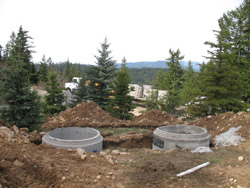
And the final pic of the second, or top
manhole being laid.
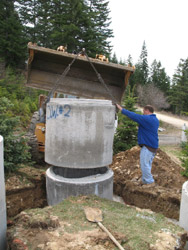
The Day of Reckoning…
The day we used to lift the tower was a BEAUTIFUL sunny day, May 11, 2011.
I decided to use a Crane Service to lift the tower, as
I thought it would be a lot easier, and save a lot of time,
versus raising it via ginpole, and manpower.
We lined up the tower perfectly, and attached the lifting
straps pretty close to the top of the tower. We couldn’t
attach at the top, as the crane couldn’t lift that
high. Also, I needed to use a regular steel cable as a lifting
strap, because the lifting hook (on the crane) needed to
be able to release from the tower WITHOUT me climbing the
tower, as at this point the tower would just be sitting
inside of the manholes without any real support. I wasn’t
climbing the tower until the concrete had set, no way.
So, the crane arrives:
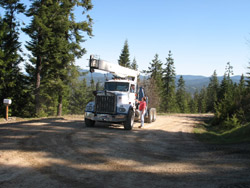
And then I get the crane hooked to the tower:
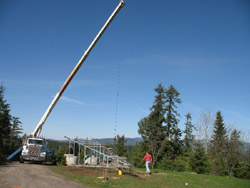
We start the lift (VERY NERVOUS here…)
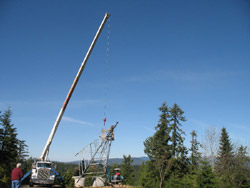
Almost there (Hyper Nervous Now…) but
it was more under control than it looks.
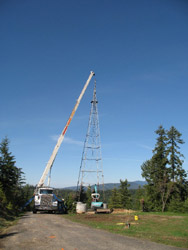
Aligning the tower with the manholes….(will it REALLY
fit ok????) We had a guy on three corners with ropes holding
it in place for lowering.
It FIT!!!!!! HALLELUJAH!!!!!! Man, I was
crazy happy that this was done!
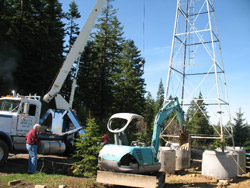
A Picture of me & the Fellow who sold
me the mill after the (nervousness)!
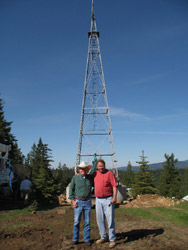
View from my house that morning:
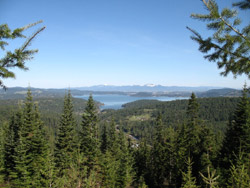
A Final Pic of the mill, from above, looking
down onto Lake Coeur d’Alene.

Now, after a lot of work on the generator head itself,
it was time to lift it. But before I do, I want to take
a minute & talk about reworking the head, and the Jacobs
themselves.
The primary reason I decided to get a Jacobs in the first
place is because they made a lot more windmills (electric)
than anyone else has, in history, over 37,000 of them produced
& installed. They last almost forever, and the reasons
are simple, incredibly well designed, and GREAT American
craftsmanship.
The primary issue with any electric windmill is the wind
ripping it apart in high wind situations. With the Jacobs,
the difference maker is that the BLADES will furl because
of centrifugal force. In other words, when the mill spins
too fast, all three blades twist (INDIVIDUALLY) out of the
wind, releasing pressure on the back side of each blade.
The disc of the blades doesn’t change, in other words,
they STILL face into the wind when furling, it’s just
that the three blades momentarily go into a very aggressive
“bite” for a few seconds, and the blades “unload”
themselves of pressure from the wind, slowing down. As soon
as they slow a little bit, springs in the governor return
the blades to their original position, and you make power
again.
Because of this, they rarely get torn apart, and this
is a GOOD thing.
When I disassembled the head at the guy’s house I
bought it from, the first thing I did was to take the entire
head & governor to East Side Electric, in Spokane WA.
They are an old Westinghouse Electric Generator Shop, and
they work on HUGE electric motors, generators, and the like,
AC & DC. After a LOT of money spent, I ended up with
a completely restored Generator & Governor, looks &
acts as good as new, or better. New brushes, new bearings,
and I had to replace the spider gear inside of the governor,
as well as one blade gear. Well worth it, I seriously doubt
I’ll ever have to go inside of it to repair it in my
lifetime.
This first picture is the head, with tail,
and no governor, getting ready to be lifted. This is a HUGE
tail, probably 10 feet or more long.
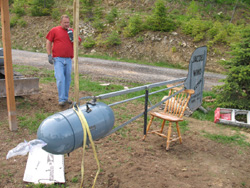
The next picture is of the original tail,
still on, still works perfect:
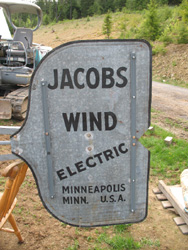
And looking up at that tower, daunting task…
Again, I hired Coeur d’Alene Crane Service to come
out & lift the Generator onto the tower. This generator
is NO JOKE, it weighs around 875 pounds, and is fine to
lift, as long as you understand that with the governor on
it it remains balanced, without the governor, it is tail
heavy. The first pic here is us installing the blades on
the governor prior to the lift. We were trying SO HARD to
be careful with the blades, they are Sitka Spruce, really
nice blades, and I wanted as close to zero damage as possible…
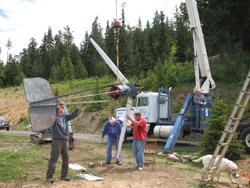
The next picture is one of my Dad, holding onto & tying
off a 500 pound string to hold onto one of the blades. When
you lift a windmill, you want to hold the blades, and NEVER
allow the wind to get them turning, no matter what. Disaster
can occur…
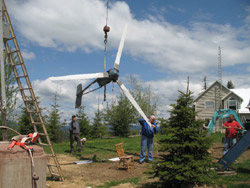
The next one is just before lifting, my
Beautiful wife, Silvia, preparing me for the climb. (NOT
looking forward to this).

I’m up on top; now BRING me that thing!
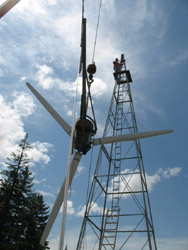
Another fairly nervous moment; the first
time I touch the blade, attached to the 875 pound generator,
50 feet off of the GROUND!!!!
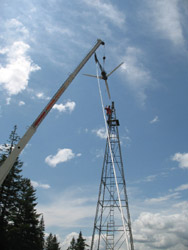
Now, I had thought that once we got the generator to the
top, it would fit into it’s mount really easy, just
set it in there & we’re done, right?
Ummm…NOPE.
It fought me. Not that the holes were in the wrong place
or anything, just was a real bear to maneuver around, once
I got one hole lined up, the rest went easy. PHEW!
Notice the big bird behind me in this pic, after we installed
the mill, larger birds (Osprey, Eagles, Hawks etc) frequent
our area of the mountain a lot more. I think they think
the mill a a UFO or something…
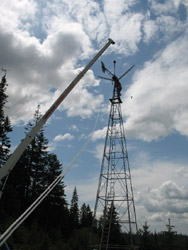
After the bolts were in, I found out that a SLIGHT breeze
had a MAJOR effect on the tail. We had to have the people
on the ground hold on to it tightly to keep it from turning
while I was trying to tighten the hold down bolts.
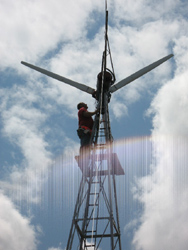
While I was up there, my Documentarian took a few other
pics. The mill sits at the end of my driveway, and is higher
than the road (where he was standing) by 10-15 feet or so.
It makes the windmill look giant, and when you’re on
it you think you’re in a plane, it is DRAMATIC.
Coming down, finally!
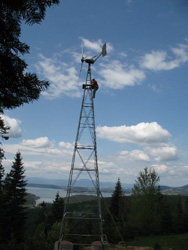
Me & My Dad, end of a pretty big day!
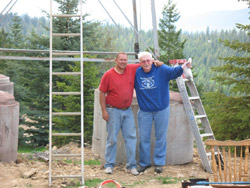
The finished product!
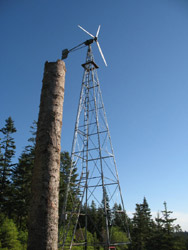
Our batteries
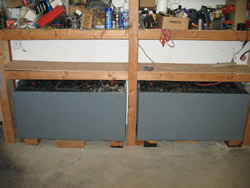
The results:
The Mill makes power, or starts making power, at between
12 & 14 MPH. At that range, it doesn’t make much,
maybe 3-10 amps, at 60VDC. In a real wind, 18-22 MPH, it
makes 40-50 Amps @ 60VDC, and charges my batteries well.
The feeling of satisfaction that I have gained from this
project is enormous, it was a lot bigger deal, a lot more
work than I thought it was going to be, but yesterday was
classic, Christmas Day, 2011, and my mill made every bit
of the power we used, and charged my batteries overnight.
It sits & spins, and the stronger the wind is, the better
I like it. It’s almost noiseless, and ridiculously
reliable. When the winds blow like a hurricane, I KNOW that
my Jacobs Mill is just fine, furling when needed, coming
back into power in a few seconds.
The Jacobs Brothers made a TREMENDOUS product, and their
Legacy lives on in people like myself that take the time
& effort to comprehend how it worked, along with the
absolute genius in their design. The Grandson of one of
the Jacobs Brothers has emailed me repeatedly, giving assistance
when asked, and I personally hope that we, as Americans,
can get more of this creative Spirit flowing again. We need
it, and it’s there, we just need to USE it.
Back To Off Grid Living
|